Rapid development of the alternative energy storage technology to rechargeable batteries is already having real world impact. James Mitchell Crow talks to the scientists working on upping their performance
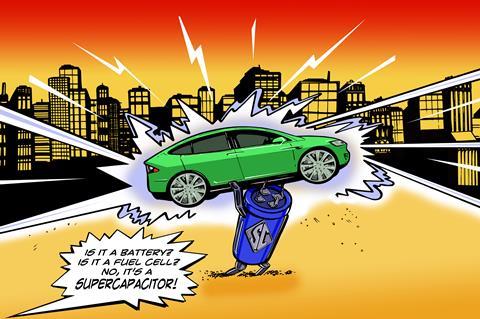
In cities from Belgrade to Shanghai, the diesel buses that have crisscrossed town for decades are being quietly replaced by an electric alternative. Many of these electric buses are powered not by batteries, but by supercapacitors.
Today’s supercapacitors hold a fraction of the energy that a lithium-ion battery can, limiting the range of a supercapacitor bus to tens rather than hundreds of kilometres. But supercapacitors can make up for this shortfall in two significant ways.
Supercapacitors’ first natural advantage is super-fast charging and discharge – a characteristic ideally matched to stop–start bus travel. At certain stops along the supercapacitor bus route, its roof-mounted recharging wire connects with an overhead charging bar as the bus comes to a halt. In the seconds that the bus is stationary while passengers alight and embark, the supercapacitor is fully recharged and ready for the next phase of the journey.
Once ready to move off, the supercapacitor’s rapid discharge capability easily delivers the power required to get the large vehicle underway, and its rapid charging readily accepts the recaptured energy delivered by regenerative braking. Many electric vehicles powered primarily by batteries, including the latest electric cars, also carry supercapacitors to assist with these tasks.
Supercapacitors’ second superpower is their longevity. Whereas lithium-ion batteries might last for a few thousand charge–discharge cycles, and will start losing capacity long before that, supercapacitors can handle millions of cycles with little to no capacity fade.

With the current buzz around rechargeable battery R&D, it can be easy to overlook the progress being made in this alternative form of electrical energy storage. Despite their obvious energy storage limitation, supercapacitors’ advantages have seen the technology deployed in a growing number of niche commercial applications.
But recent work in the lab on ‘pseudocapacitive’ electrode materials, which combine supercapacitor-like power delivery with more battery-like energy storage capacity, suggests supercapacitors could soon find much broader use. The latest findings suggest that battery and supercapacitor materials research is beginning to merge, combining the best attributes of both to create the ultimate energy storage technology.
Super carbon
For any electrical energy storage device, the two key performance metrics are their energy and power outputs, says Scott Donne, who studies supercapacitor and battery materials at the University of Newcastle in Australia. Energy refers to the amount of electrical energy the storage device can hold, while power defines the speed with which that energy can be put in and taken out.
The overarching goal in energy storage research is to deliver high power and high energy from a single device. So far, that goal has proven elusive, Donne says. ‘You’ve got capacitors with high power but low energy; fuel cells with high energy but low power; and batteries sit in the middle – which is why they are the most popular of the three,’ he says.
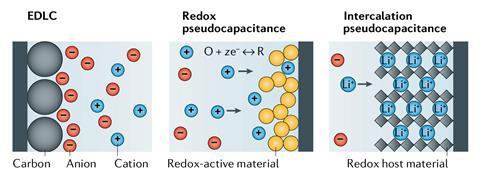
Batteries come with the fewest compromises for most electrical energy storage applications, but their short lifespan and limited power performance are increasingly problematic as the world electrifies its energy and transport systems. While many researchers work on boosting battery performance, others are approaching the problem from the opposite direction, seeking to up the energy density of capacitors.
The different performance profile of capacitors compared to batteries comes down to their alternative mode of storing energy. In a capacitor, it’s all about the electrode surface. The simplest capacitors are the ‘parallel plate’ devices used in electronic circuits, which consist of two metal conductors separated by a dielectric material. When a voltage is applied, current can’t cross the dielectric so charge accumulates on the two plates, storing the electrical energy until required. ‘These devices have a very small capacitance and very fast response time, which suits the purposes of circuit boards perfectly,’ Donne says.
Adding an electrolyte between the electrodes, to create a device called an electric double layer capacitor (EDLC), ups the electrical storage capacity. Electrolytic capacitors store energy via the electrostatic interaction between ions in the electrolyte and the accumulated charge on the electrode surface.
Supercapacitors push the EDLC concept to its maximum, by using electrodes with a very high surface area, usually made from nanoporous carbon. ‘Carbon-based supercapacitors can have electrode surface areas of 2000m2 per gram of material,’ Donne says. ‘Because they’ve got a much higher surface area, they’ve got greater energy storage – but it is still purely physical charge storage at the electrode surface,’ he says.
Despite this ultimate performance ceiling, significant effort has been made to push nanoporous carbon supercapacitor energy storage to its limit. Structure–activity studies have gradually clarified how nanoporous carbons’ structural features impact energy density. One key insight was to reevaluate the impact of the size of the nanopores in the carbon electrode.
The traditional view was that shrinking the pore size to below that of the solvated ion in the electrolyte would reduce the capacitance of the material. But in 2006, Yury Gogotsi from Drexel University in Philadelphia, US, and Patrice Simon from Université Paul Sabatier in Toulouse, France, showed that if you shrink the pore size far enough past this limit, the trend reverses dramatically.
Removing some of the solvent molecules from around the ion increased the capacitance
Supercapacitor nanoporous carbon electrodes are low-cost materials usually made from heat-treated organic waste, such as coconut husk. Gogotsi and Simon used a more controlled approach, selecting a metal carbide lattice as a starting material for the nanoporous carbon. A high-temperature chlorination step strips the metal from the lattice as the metal chloride, leaving a porous carbon material with a tuneable 0.5–3 nm pore size and very narrow pore size distribution.
Using this approach, the team showed that when pore size falls into a narrow range of around just 1nm in size, capacitance jumps up by 100%. Disrupting the solvation sphere around the ion by squeezing it into narrow pores upped the energy storage. ‘Removing some of the solvent molecules from around the ion increased the capacitance,’ says Thierry Brousse, a supercapacitor materials researcher at the University of Nantes in France.
Measuring mess
The latest findings show there’s more to the story than pore size. For the past few years, Alex Forse at the University of Cambridge, UK, has been studying nanoporous carbons using an unusual NMR technique, which he originally developed over a decade ago as a PhD student in the group of Clare Grey, also at Cambridge.
‘At that time, we found that the position of the NMR peaks depends on how messy the material is – or, more scientifically, on the typical sizes of the graphene-like fragments of carbon before you get to a defect,’ Forse says. The NMR technique offers a way to quantify the level of structural disorder in a carbon material.
‘During my PhD it was difficult to see how this hard, fundamental work could ever be useful,’ says Forse. But in 2022, the team revisited the technique to investigate inconsistencies in the literature about the relationship between pore size and capacitance. ‘It wasn’t our initial hypothesis, but we found a connection between how disordered the electrode material is, and how high its capacitance is,’ Forse says. ‘If you go from an ordered material approaching perfect graphene, to a very messy electrode with clusters of only five or six aromatic rings joining together, you can almost double how much energy you can store.’
At some stage you are not able to produce a carbon that has smaller and smaller ordered areas
As long as the pore size of the carbon material is in roughly the right sub-2nm range, electrode disorder is the key factor in its performance, the team found. ‘The field was a little bit stuck, because the design principles were unclear, but now we hope we’ve got a new principle to take this forward,’ Forse says.
Incorporating the finding into device design is not straightforward, he notes. ‘The challenge is to make materials where you can control these parameters, because when you’ve got a messy material, it’s incredibly hard to control the porosity and disorder.’
For Brousse, the level of disorder already found in nanoporous carbon electrode materials suggests there is little further energy storage performance left to be gained for this type of supercapacitor – although other researchers have continued to try (see box Oxygen grab below). ‘Despite these interesting fundamental advances, I would say that we have reached a maximum,’ Brousse says. ‘At some stage you are not able to produce a carbon that has smaller and smaller ordered areas, because of the fabrication limits of the material itself.’
In Brousse’s lab, the focus is on materials that display a different form of capacitive behaviour. ‘We are looking at storing charge not by electrostatic interaction, but by a redox process.’
Oxygen grab
How far might it be possible to push the performance of a nanoporous carbon supercapacitor? A paper published in 2023 by researchers at Oak Ridge National Lab, US, set out to answer that question.
‘A group in our centre developed a machine learning technology which used data from the literature to find a relationship between key parameters like pore size, surface area and oxygen or nitrogen doping,’ says Tao Wang, a researcher in the team of Sheng Dai, who led the work. The AI predicted that carbons with a very high surface area, and also a high percentage of oxygen in the structure, should give the optimal performance.
‘Storing energy based only on electric double layer capacitor behaviour is highly limited,’ Wang says. ‘But if you add some oxygen or nitrogen doping, you can achieve a much higher capacitance by pseudocapacitive [see main article] oxygen or nitrogen redox reactions.’
Based on the machine learning analysis, the team’s target was 20atom% of oxygen in the electrode. ‘That’s a huge amount of oxygen, because to get the hyper-porous structure you have to heat it at a high temperature, which will cause oxygen or nitrogen loss,’ Wang says. To overcome the problem, the team used sodium amide activation for the hyper-porous carbon production step, which enabled them to lower the temperature from 900°C to 600°C. ‘This enabled us to keep 15atom% oxygen.’
Adding oxygen clearly upped the capacity of the electrode, the team showed. Exploring the scale up of the material, and investigating its performance in non-aqueous electrolytes, are the next steps, Wang says. ‘We are in discussion with a company interested in developing our discovery,’ he adds.
Pseudocaps
The first indication that materials with capacitor-like performance could operate via more battery-like redox-based charge storage mechanisms came in the 1960s, with the electrochemical exploration of ruthenium dioxide. In mildly acidic aqueous solutions, this hydrous nanoporous material displayed the electrochemical and power behaviour typical of a capacitor. Yet its energy storage capacity was significantly higher than any EDLC material.
‘Ruthenium dioxide was the first generation “pseudocapacitive” material, which behaves like an electric double layer capacitor but has a charge storage mechanism that is different,’ says Donne. Rather than simply accumulating charge on its surface, the metal oxide soaks up far more electrons by undergoing a redox reaction, changing from ruthenium(iv) to ruthenium(ii). Electron flow into and out of the material is balanced by the rapid insertion or removal of electrolyte protons at the surface or near-surface of the electrode material.

‘The changing oxidation state in pseudocapacitive materials has a huge consequence for the capacitance, because you are no longer only playing with the outer surface, but also a layer a few angstroms deep,’ says Brousse. Unlike in a battery electrode, however, the bulk of the electrode remains unaffected by charge and discharge. This surface-restricted process prevents the stressful volumetric changes to the electrode bulk that typically accompanies charge and discharge in batteries, constraining battery lifespan.
Ruthenium dioxide is also an excellent electrical conductor and might have made an ideal high-power high-energy storage device – were it not for ruthenium’s prohibitively high price. Ruthenium dioxide energy storage devices have been restricted to military applications.
Searching for an inexpensive alternative, researchers discovered that manganese dioxide also shows pseudocapacitive behaviour. ‘It does have very good redox chemistry and can store a lot of charge,’ says Donne, whose own work has focused on developing analytical techniques to differentiate redox and non-redox charge storage in capacitive materials. ‘But manganese dioxide is not as good as ruthenium dioxide, and it’s a semiconductor rather than a conductor,’ Donne says. ‘And it’s still an aqueous-based system,’ he adds.
The wider the voltage window that a pseudocapacitive device can operate in, the more energy it could store. ‘The limitation of water-based electrolytes is that the water decomposition potential window is just 1.23V,’ says Brousse. With the exceptional inherent performance of ruthenium dioxide, it was possible to shrug off the need for an aqueous electrolyte – but for manganese dioxide, it was a compromise too far. ‘Unfortunately, currently nearly all the materials that show pseudocapacitive behaviour material are operated in aqueous electrolyte,’ Brousse adds.
Just as for carbon-based supercapacitors, a fundamental performance ceiling seemed set to thwart the possibility of high-energy high-power energy storage based on pseudocapacitors.
Lithium-ion capacitors
Bruce Dunn’s interest in pseudocapacitive materials was first captured by an old paper by Canadian electrochemist Brian Conway, describing the two known pseudocapacitive materials of the day, ruthenium dioxide and manganese dioxide. ‘As a material scientist, I thought “Surely we should be able to do something more than that,”’ says Dunn, who studies electrochemical materials at the University of California, Los Angeles, US.
Dunn set out to look for more pseudocapacitive materials. ‘There were enough caveats in Conway’s work that they gave me some ideas on what to do,’ he says. ‘One of the most important ones had to do with the effect of size of the structure.’ Given that electrolyte ion interaction with the electrode’s surface layers seemed to be key, creating electrode materials with the right nano-architecture might offer new pseudocapacitive materials.
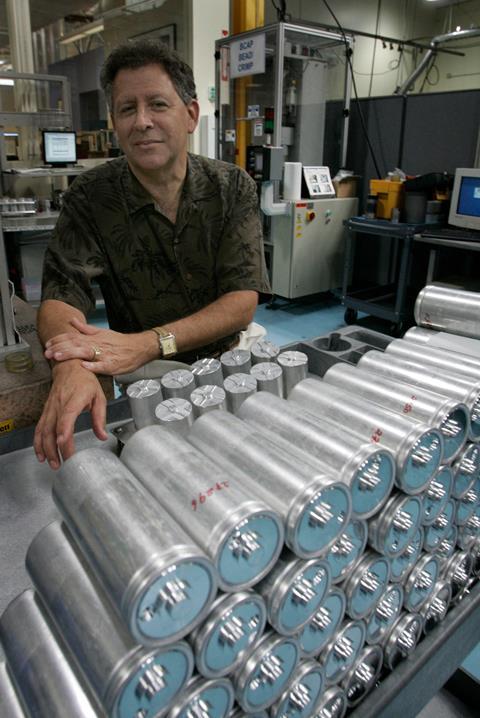
Dunn started to assemble mesoporous materials, using sol-gel chemistry based on directing species such as diblock copolymers and surfactants to precisely control pore size. ‘You would wind up with just gorgeous materials, with pore sizes you could dial in – but the most important thing was that the walls were just a few nanometres thick, which made all the difference in the world.’
By creating porous nanostructured materials, the team showed that molybdenum trioxide and titanium dioxide could also behave as pseudocapacitors. One material in particular, niobium oxide (Nb2 O5), was the standout performer. ‘It had extraordinary kinetics, much faster charge and discharge than anything else we’d made, and we began to realise, this is what pseudocapacitance enables you to do.’
Dunn ascribes niobium oxide’s fast kinetics to the two-dimensional crystallographic pathways within the mesoporous material, which enabled very rapid electrolyte ion diffusion to balance the niobium redox reactions that take place during charge and discharge.
Adding significantly to niobium oxide’s appeal, the ion in question is lithium, and the electrode operates in a non-aqueous electrolyte. Since Dunn’s discovery, a range of non-aqueous lithium ion based pseudocapacitive electrode materials have now been found, many of them borrowed directly from the lithium-ion battery world.
Lithium cobalt oxide, for example, is commonly used as an electrode material in lithium-ion batteries. ‘But if you synthesise very tiny particles of lithium cobalt oxide, you will end up with a large part of pseudocapacitor versus battery type behaviour,’ Brousse says. A team in Japan also showed that you could take another common lithium-ion battery electrode material, lithium titanate, and combine it with carbon nanotubes to create a pseudocapacitive material.
The ideal next step would be to pair two non-aqueous pseudocapacitive materials, one to form the negative electrode and the other to form the positive electrode, to create an energy storage device combining high energy storage with excellent power performance and cycle life. Unfortunately, while niobium oxide is one of several good pseudocapacitive materials for the negative electrode, none of the pseudocapacitor materials identified so far are suitable positive electrode candidates.
You can find complex structures with very big tunnels
‘It is not really clear why we can’t find good positive electrode materials,’ Dunn says. ‘We see aspects of pseudocapacitance in some positive electrode materials, but it’s not complete.’ Dunn recently teamed up with computational researchers to hunt for suitable materials.
Brousse, meanwhile, has hit the library. ‘I’ve got books on solid state chemistry from the 1980s, full of the fancy structures that were they were investigating at a time,’ he says. The researchers didn’t have energy storage in mind, says Brousse. The images were captured for the beauty of the crystallography. But the structures might feature, say, niobium or titanium octahedra, templated with big cations such as rubidium. ‘You can find complex structures with very big tunnels that are full of caesium or rubidium,’ Brousse says. ‘If you could remove the templating cation and replace it with lithium, you could end up with a structure in which the lithium will go in and out very quickly.’ A range of candidate materials is now being investigated in Brousse’s lab.
Harnessing hybrids
As a step toward the ultimate all-pseudocapacitor device, researchers have created hybrid devices that use a battery-type activated carbon material as the positive electrode, and a material such as niobium oxide as the negative.
These lithium-ion capacitors can reach approximately double the energy density of a regular supercapacitor, says Brousse. ‘A standard supercap will not reach more about 10watt-hours per kilogram,’ he says. ‘For lithium-ion capacitors, the maximum I have seen is around 20Wh per kilogram,’ he says. That’s still a way off the nearly 200Wh per kilogram of a lithium-ion battery using a nickel manganese cobalt electrode. It is not far from the useful 30Wh per kilogram energy density of a lead acid battery, however, and it adds very fast charge and discharge.
Brousse is currently one year into a six-year French government funded project with an ambitious target in mind. ‘The target is for our hybrid supercapacitor–battery to reach 50Wh per kilogram energy density, within one minute charging,’ he says.
As well as revisiting old crystallographic materials to look for new pseudocapacitive leads, the team is exploring the potential of adding additional nanostructure to lithium-ion battery electrode materials such as lithium cobalt oxide, which show pseudocapacitive behaviour when scaled down.
Electric vehicle circuit designers are not waiting around for one material to do everything
‘We are trying to take these very nice 2µm diameter lithium cobalt oxide grains and create tracks inside the grain where the lithium and the electrolyte can access very quickly,’ Brousse says. The change should push the material even further from battery-like to pseudocapacitor-like charge and discharge speeds, without significantly compromising its energy storage capacity.
The third thrust is to boost device performance by enlarging the voltage window, Brousse adds. ‘If you are able to tune the surface of your activated carbon positive electrode, you could probably reach as high as 5V without affecting the carbon – which will, in turn, increase the energy density.’
One way or another, battery–capacitor combination devices will soon be powering mobile applications, Donne says. ‘I believe that the portable power packs of the future will be hybrid systems – whether it is at the material level combining capacitive and battery type materials; at the electrode level; or at the device level, so you have a battery pack and a capacitor pack that interface together to power your system.’
This transition has already begun, Dunn says. ‘Electric vehicle circuit designers are not waiting around for one material to do everything, they are already combining supercapacitors with batteries to optimise performance,’ he says. Whether the ultimate device combines supercapacitors and batteries at the device level or the material level remains to be seen, he adds. ‘But that’s why you investigate materials.’
James Mitchell Crow is a science writer based in Melbourne, Australia






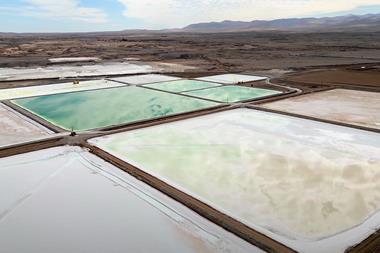
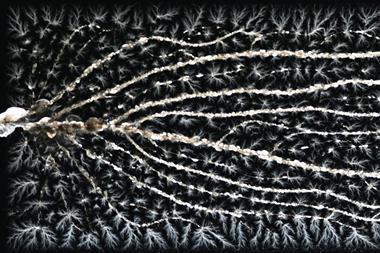
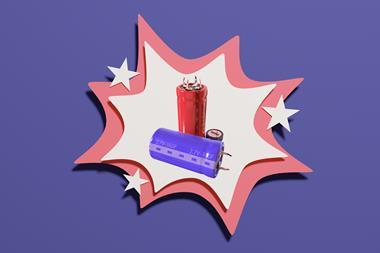








No comments yet